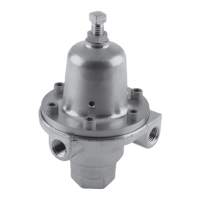Types 1301F and 1301G
4
!
WARNING
A regulator may vent some gas to the
atmosphere. In hazardous gas service,
vented gas may accumulate, causing
personal injury or equipment damage
due to re or explosion. Vent a regulator
in hazardous gas service to a remote,
safe location.
The optional brass spring case of the Type 1301F
regulator has one 1/4 NPT internal connection.
The Type 1301G regulator spring case has one
1/8 NPT internal connection with a screen. To remotely
vent the spring case, remove the screen, if present, and
connect 1/4 or 1/8 NPT piping or tubing to the spring
case connection. The piping or tubing should vent the
spring case to a safe location, have as few bends as
possible, and have a screened vent on its exhaust end.
Each regulator is factory-set for the pressure setting
specied on the order. If no setting is specied,
outlet pressure is factory-set at the midpoint of the
regulator spring range. If pressure adjustment is
necessary, refer to the Startup section. In all cases,
check the spring setting to make sure it is correct for
the application.
Overpressure Protection
The 1301 Series regulators have an outlet pressure
rating lower than their inlet pressure rating. If actual
inlet pressure can exceed the outlet pressure rating,
outlet overpressure protection is necessary. However,
overpressuring any portion of the regulators beyond
the limits in Specications section may cause leakage,
damage to regulator parts, or personal injury due to
bursting of pressure-containing parts.
Some type of external overpressure protection should be
provided if inlet pressure will be high enough to damage
downstream equipment. Common methods of external
overpressure protection include relief valves, monitoring
regulators, shutoff devices, and series regulation.
If the regulator is exposed to an overpressure
condition, it should be inspected for any damage that
may have occurred. Regulator operation below these
limits does not preclude the possibility of damage from
external sources or from debris in the pipeline.
Startup
With installation completed and downstream
equipment adjusted, slowly open the upstream and
downstream block valves while using pressure gauges
to monitor pressure.
If adjustment is necessary, remove the closing cap,
and, if one is used, loosen the locknut (key 18,
Figures 3 and 4), and turn the adjusting screw (key 15,
Figures 3 and 4) clockwise to increase the set
pressure or counterclockwise to decrease the set
pressure. Monitor pressure with gauges during
adjustment. When adjustment is complete, tighten
the locknut, and, if one is used, replace the closing
cap. If the desired outlet pressure is not within the
range of the regulator spring, install a spring with a
desired range according to the Maintenance section.
Shutdown
First, close the upstream shutoff valve, and then,
close the downstream shutoff valve. Next, open the
vent valve between the regulator and the downstream
shutoff valve and open the vent valve between the
regulator and the upstream shutoff valve. If vent
valves are not installed, safely bleed off both inlet and
outlet pressures and check that the regulator contains
no pressure.
Maintenance
Regulator parts are subject to normal wear and
must be inspected and replaced as necessary.
The frequency of inspection and parts replacement
depends on the severity of service conditions and
the requirements of local, state, and federal rules
and regulations.
Instructions are given below for disassembly and
assembly of parts.
!
WARNING
To avoid personal injury or equipment
damage from sudden release of
pressure or explosion of accumulated
gas, do not attempt any maintenance
or disassembly without rst isolating
the regulator from system pressure
and relieving all internal pressure
from the regulator.

